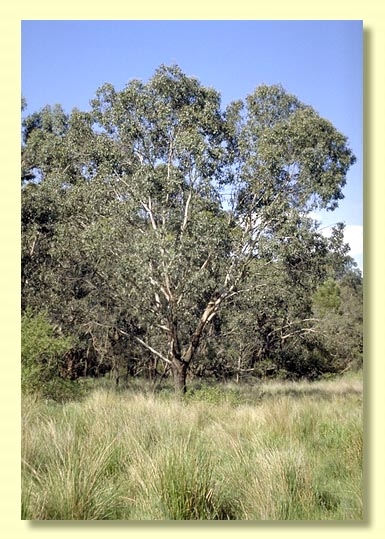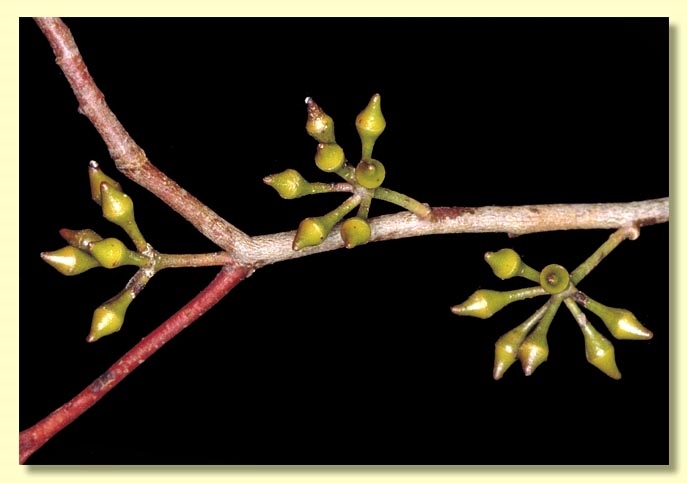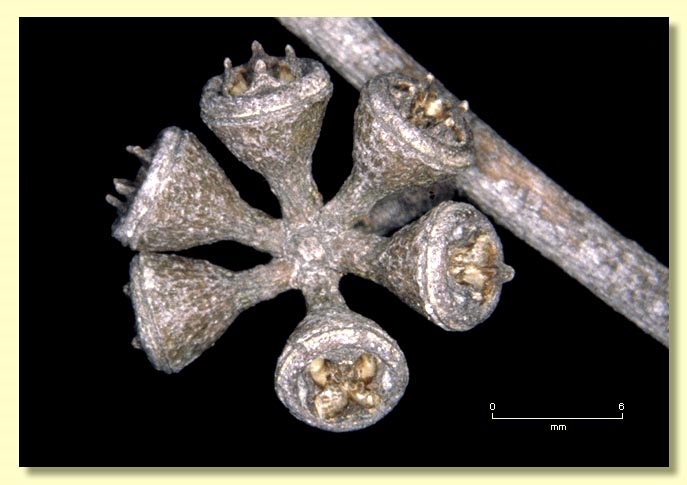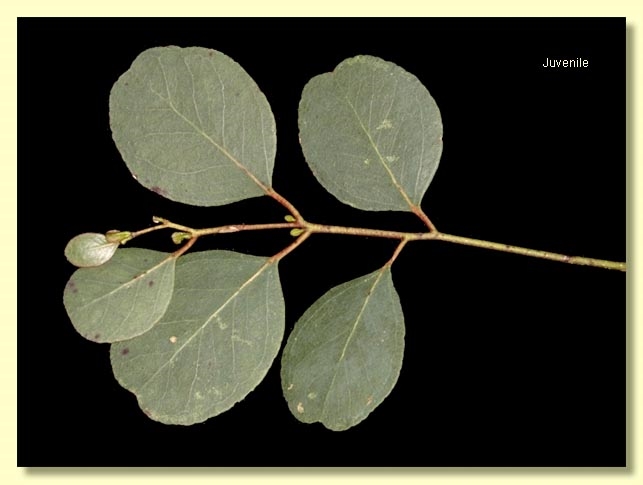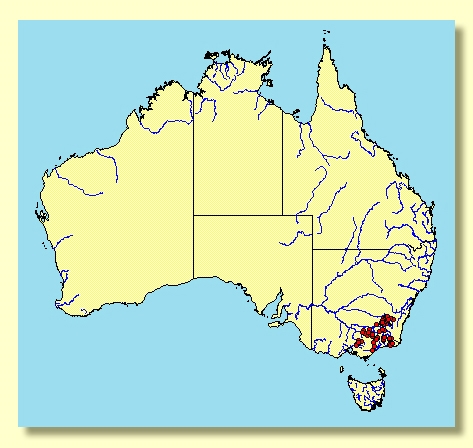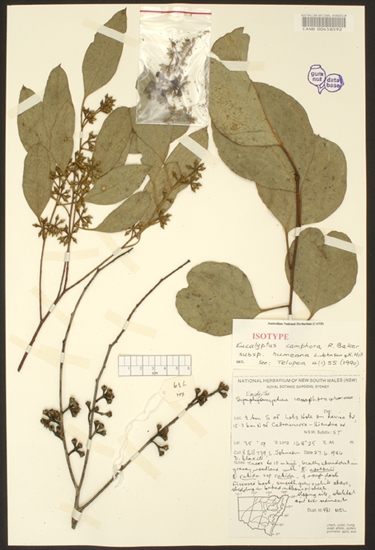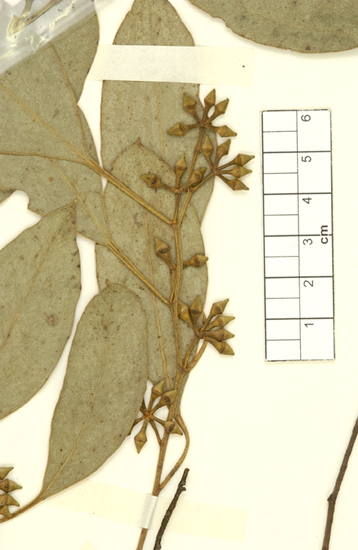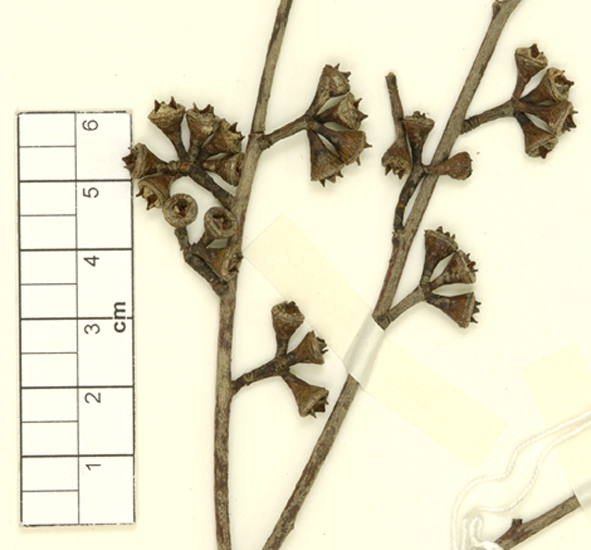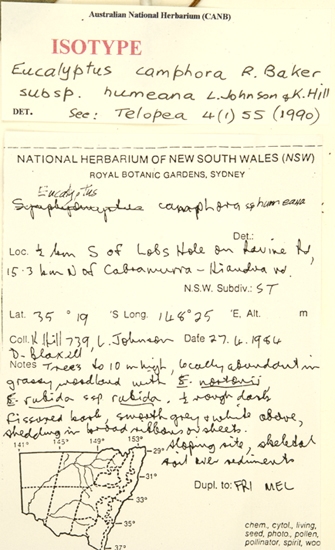Euclid - Online edition
Eucalyptus camphora subsp. humeana
Classification
Eucalyptus | Symphyomyrtus | Maidenaria | Triangulares | Foveolatae
Nomenclature
Description
Tree to 25 m tall, or mallee to 10 m tall. Forming a lignotuber.
Bark smooth throughout or partly rough on lower trunk; rough bark either loose basal slabs, or compacted, dark brown, grey or blackish; smooth bark white-grey to grey-green, green or yellow-grey, sometimes slightly powdery.
Juvenile growth (coppice or field seedlings to 50 cm): stem rounded in cross-section; juvenile leaves opposite for several pairs, petiolate, becoming alternate, orbicular to ovate or elliptical, 3–5 cm long, 2.5–4.6 cm wide, margin entire or crenulate, apex emarginate or rounded, green or bluish green.
Adult leaves alternate, petiole 1.8–4 cm long; blade broadly lanceolate, elliptical to ovate or obovate, 6–15 cm long, 2.5–6 cm wide, base tapering to petiole, margin entire, apex often rounded or emarginate, concolorous, usually glossy, green, side-veins irregular, reticulation usually dense, intramarginal vein parallel to and well removed from margin, oil glands island and intersectional. Leaves often appear pendulous in the crown because of the long petioles.
Inflorescence axillary unbranched, peduncles 0.5–1.5 cm long, buds 7 per umbel, pedicels 0.2–0.6 cm long. Mature buds fusiform to diamond-shaped (0.4–0.8 cm long, 0.3–0.5 cm wide), green to yellow, scar present, operculum conical to beaked (0.3–0.6 cm long), stamens inflexed or irregularly flexed, anthers cuboid or cuneate, versatile, dorsifixed, dehiscing by longitudinal slits (non-confluent), style long, stigma blunt, locules 3 or 4, the placentae each with 4 vertical ovule rows. Flowers white.
Fruit pedicellate (pedicels 0.3–0.4 cm long), obconical, 0.2–0.5 cm long, 0.4–0.6 cm wide, disc raised-annular or -convex, or disc level, valves 3 or 4, slightly exserted, or near rim level.
Seeds black, brown or grey, 1–2.5 mm long, ovoid or flattened-ovoid, often pointed at one end, usually lacunose, dorsal surface smooth or shallowly pitted, hilum ventral.
Cultivated seedlings (measured at ca node 10): cotyledons bilobed to oblong; stems usually rounded in cross-section; leaves sessile to shortly petiolate at first, opposite for 4 to 10 nodes then alternate with the petioles becoming longer, ovate-elliptic to oblong or more or less orbicular, 2–6 cm long, 1.5–3.5 cm wide, base tapering, margin entire or subcrenulate, apex rounded or emarginate, more or less concolorous, dull, mid-green to slightly bluish green.
Bark smooth throughout or partly rough on lower trunk; rough bark either loose basal slabs, or compacted, dark brown, grey or blackish; smooth bark white-grey to grey-green, green or yellow-grey, sometimes slightly powdery.
Juvenile growth (coppice or field seedlings to 50 cm): stem rounded in cross-section; juvenile leaves opposite for several pairs, petiolate, becoming alternate, orbicular to ovate or elliptical, 3–5 cm long, 2.5–4.6 cm wide, margin entire or crenulate, apex emarginate or rounded, green or bluish green.
Adult leaves alternate, petiole 1.8–4 cm long; blade broadly lanceolate, elliptical to ovate or obovate, 6–15 cm long, 2.5–6 cm wide, base tapering to petiole, margin entire, apex often rounded or emarginate, concolorous, usually glossy, green, side-veins irregular, reticulation usually dense, intramarginal vein parallel to and well removed from margin, oil glands island and intersectional. Leaves often appear pendulous in the crown because of the long petioles.
Inflorescence axillary unbranched, peduncles 0.5–1.5 cm long, buds 7 per umbel, pedicels 0.2–0.6 cm long. Mature buds fusiform to diamond-shaped (0.4–0.8 cm long, 0.3–0.5 cm wide), green to yellow, scar present, operculum conical to beaked (0.3–0.6 cm long), stamens inflexed or irregularly flexed, anthers cuboid or cuneate, versatile, dorsifixed, dehiscing by longitudinal slits (non-confluent), style long, stigma blunt, locules 3 or 4, the placentae each with 4 vertical ovule rows. Flowers white.
Fruit pedicellate (pedicels 0.3–0.4 cm long), obconical, 0.2–0.5 cm long, 0.4–0.6 cm wide, disc raised-annular or -convex, or disc level, valves 3 or 4, slightly exserted, or near rim level.
Seeds black, brown or grey, 1–2.5 mm long, ovoid or flattened-ovoid, often pointed at one end, usually lacunose, dorsal surface smooth or shallowly pitted, hilum ventral.
Cultivated seedlings (measured at ca node 10): cotyledons bilobed to oblong; stems usually rounded in cross-section; leaves sessile to shortly petiolate at first, opposite for 4 to 10 nodes then alternate with the petioles becoming longer, ovate-elliptic to oblong or more or less orbicular, 2–6 cm long, 1.5–3.5 cm wide, base tapering, margin entire or subcrenulate, apex rounded or emarginate, more or less concolorous, dull, mid-green to slightly bluish green.
Flowering Time
Flowering has been recorded in February, March and April.
Notes
Eucalyptus camphora is a species of small to medium-sized swamp gum trees of low-lying areas of the high plains and valleys extending sporadically from southern Queensland through New South Wales and Victoria. It has the typical swamp gum double conic buds and obconical fruit.
In EUCLID we recognize two subspecies of E. camphora:
E. camphora subsp. camphora
Distinguished by the low stature and small, elliptical leaves often with rounded to emarginate tips. Has a scattered distribution from the Girraween National Park in southern Queensland, then south across the border into New South Wales to just south-east of Glen Innes on the Northern Tablelands to east of Rylstone to south-east of Mittagong. The two northern populations were described as E. camphora subsp. relicta and the southern population as E. aquatica. Both are regarded by the authors of EUCLID as not being sufficently distinct from E. camphora subsp. camphora to warrant recognition.
E. camphora subsp. humeana
Subspecies humeana is the more conspicuous form in mountains from north-west of Canberra extending south through Bombala and Kosciuszko National Park into eastern Victoria extending as far west as the Warby Range and Broadford. It has broad, glossy leaves that are often pendulous in the crown and because of this can easily be recognised from a distance in swampy sites.
Eucalyptus camphora belongs in Eucalyptus subgenus Symphyomyrtus section Maidenaria because the cotyledons are bilobed, inflorescences axillary, anthers versatile and seeds flattened-ovoid. Within this large section, E. camphora is one of ten species forming subsection Triangulares series Foveolatae. The species are E. barberi and E. rodwayi (both Tasmanian endemics), E. brookeriana, E. ovata (both occurring in Tasmania and on the mainland) and E. aggregata, E. cadens, E. camphora, E. macarthurii, E. strzeleckii and E. yarraensis (found only on the mainland). E. camphora is closest to E. ovata and E. yarraensis, but is distinguished by its broader, long petiolate adult leaves from E. ovata, and differs noticeably from E. yarraensis, which has extensive rough bark and smaller fruit.
E. aquatica, regarded by the authors of EUCLID as synonymous with E. camphora subsp. camphora, is listed as "Vulnerable" under the Australian Government Environment Protection and Biodiversity Conservation Act 1999 (EPBC Act). Further information may be found at this web address:
http://www.environment.gov.au/cgi-bin/sprat/public/sprat.pl
In EUCLID we recognize two subspecies of E. camphora:
E. camphora subsp. camphora
Distinguished by the low stature and small, elliptical leaves often with rounded to emarginate tips. Has a scattered distribution from the Girraween National Park in southern Queensland, then south across the border into New South Wales to just south-east of Glen Innes on the Northern Tablelands to east of Rylstone to south-east of Mittagong. The two northern populations were described as E. camphora subsp. relicta and the southern population as E. aquatica. Both are regarded by the authors of EUCLID as not being sufficently distinct from E. camphora subsp. camphora to warrant recognition.
E. camphora subsp. humeana
Subspecies humeana is the more conspicuous form in mountains from north-west of Canberra extending south through Bombala and Kosciuszko National Park into eastern Victoria extending as far west as the Warby Range and Broadford. It has broad, glossy leaves that are often pendulous in the crown and because of this can easily be recognised from a distance in swampy sites.
Eucalyptus camphora belongs in Eucalyptus subgenus Symphyomyrtus section Maidenaria because the cotyledons are bilobed, inflorescences axillary, anthers versatile and seeds flattened-ovoid. Within this large section, E. camphora is one of ten species forming subsection Triangulares series Foveolatae. The species are E. barberi and E. rodwayi (both Tasmanian endemics), E. brookeriana, E. ovata (both occurring in Tasmania and on the mainland) and E. aggregata, E. cadens, E. camphora, E. macarthurii, E. strzeleckii and E. yarraensis (found only on the mainland). E. camphora is closest to E. ovata and E. yarraensis, but is distinguished by its broader, long petiolate adult leaves from E. ovata, and differs noticeably from E. yarraensis, which has extensive rough bark and smaller fruit.
E. aquatica, regarded by the authors of EUCLID as synonymous with E. camphora subsp. camphora, is listed as "Vulnerable" under the Australian Government Environment Protection and Biodiversity Conservation Act 1999 (EPBC Act). Further information may be found at this web address:
http://www.environment.gov.au/cgi-bin/sprat/public/sprat.pl
Origin of Name
Eucalyptus camphora: refers to camphor in the essential oils of the leaf.
subsp. humeana: after Hamilton Hume (1797–1872). Hamilton Hume was an early Australian explorer who, with William Hovell (an English sea captain) and six convicts, travelled overland through southeast Australia (the Berrima–Bong Bong District) to look for any large rivers. They set out in 1824 from Appin and travelled from Gunning to Corio Bay, discovering the Murray River, the Murrumbidgee River, and Mount Bland. They returned in 1825. Hume was rewarded with hundreds of acres of land in the Yass district.
subsp. humeana: after Hamilton Hume (1797–1872). Hamilton Hume was an early Australian explorer who, with William Hovell (an English sea captain) and six convicts, travelled overland through southeast Australia (the Berrima–Bong Bong District) to look for any large rivers. They set out in 1824 from Appin and travelled from Gunning to Corio Bay, discovering the Murray River, the Murrumbidgee River, and Mount Bland. They returned in 1825. Hume was rewarded with hundreds of acres of land in the Yass district.
Copyright © CANBR 2020, all rights reserved.

Web edition hosted at https://apps.lucidcentral.org/euclid
